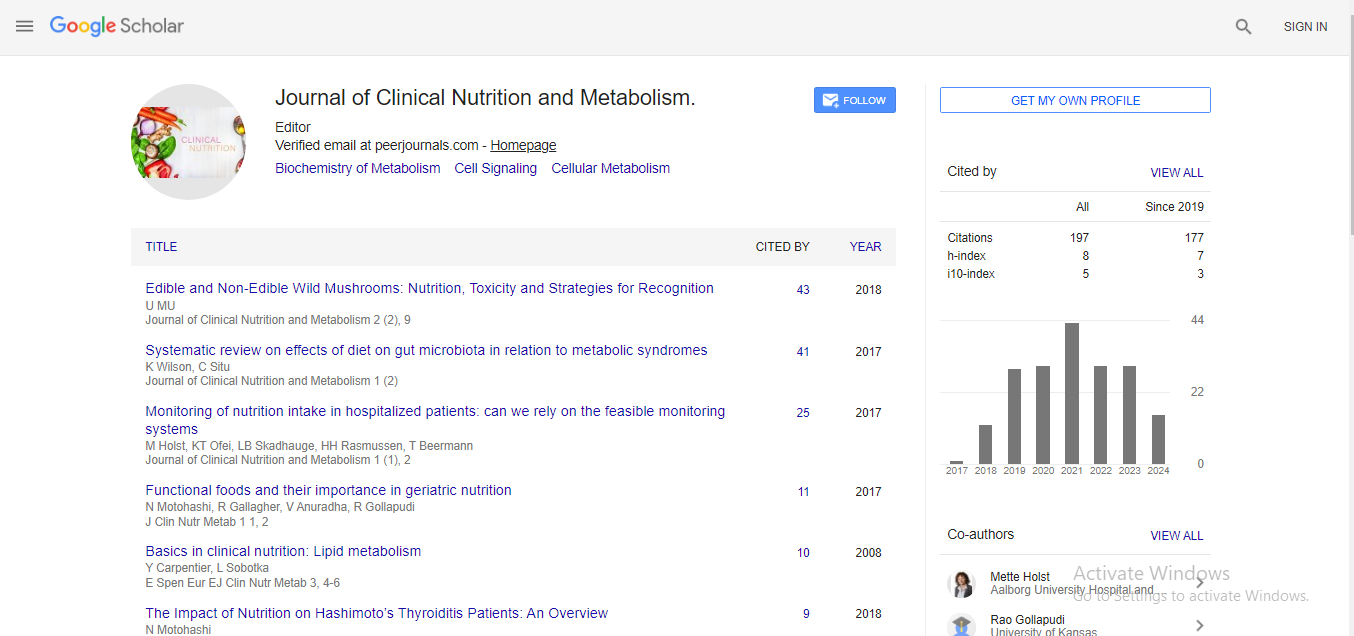Short Communication, J Clin Nutr Metab Vol: 8 Issue: 4
Nutritional Management of Sarcopenia in Aging Adults: Insights from Recent Research
Phillip Tawanda*
1Department of Biochemistry and Microbiology, University of Maine, Orono, United States of America
*Corresponding Author: Phillip Tawanda,
Department of Biochemistry and
Microbiology, University of Maine, Orono, United States of America
E-mail: phill_wanda784@uom.edu
Received date: 26 November, 2024, Manuscript No. JCNM-24-154794;
Editor assigned date: 28 November, 2024, PreQC No. JCNM-24-154794 (PQ);
Reviewed date: 12 December, 2024, QC No. JCNM-24-154794;
Revised date: 19 December, 2024, Manuscript No. JCNM-24-154794 (R);
Published date: 27 December, 2024, DOI: 10.35841/JCNM.1000167
Citation: Tawanda P (2024) Nutritional Management of Sarcopenia in Aging Adults: Awareness from Recent Research. J Clin Nutr Metab 8:4.
Description
Sarcopenia, a progressive loss of skeletal muscle mass, strength and function, is a common condition among aging adults. It poses significant risks for physical disability, reduced quality of life and mortality. While exercise is a base of sarcopenia management, nutritional interventions play a vital role in reducing its progression. Defined by the European Working Group on Sarcopenia in Older People (EWGSOP), it involves low muscle mass and function, contributing to frailty and increased healthcare costs [1-3]. Nutrition is a modifiable factor that can support muscle preservation and enhance the effectiveness of exercise interventions.
The etiology of sarcopenia is multifactorial, involving age-related changes reduced muscle protein synthesis due to decreased anabolic signaling. Chronic Inflammation, elevated levels of pro-inflammatory cytokines (e.g., TNF-α, IL-6) accelerate muscle degradation. Hormonal Changes decline in anabolic hormones such as testosterone and growth hormone. Inadequate intake of protein, amino acids and micronutrients increases muscle loss.
Understanding these mechanisms highlights the importance of targeted nutritional interventions to neutralize sarcopenia. Adequate protein intake is essential for maintaining muscle mass and function. Aging adults require higher protein intakes (1.2 g/kg/day–1.5 g/kg/day) compared to the general population (0.8 g/kg/day) to combat anabolic resistance. Distributing protein intake evenly across meals maximizes muscle protein synthesis. High-quality protein sources, such as lean meats, dairy, eggs and plant-based proteins, are beneficial. Whey protein is particularly effective due to its high leucine content, which stimulates muscle protein synthesis [4-6].
Leucine is a Branched-Chain Amino Acid (BCAA) directly activates the mTOR pathway, which regulates muscle protein synthesis. Supplementation with leucine-rich diets or products has shown positive effects on muscle mass and strength in older adults. Supplementing with Essential Amino Acids (EAAs) has demonstrated benefits in increasing muscle protein synthesis, particularly when dietary protein intake is inadequate. Vitamin D plays a vital role in muscle health through its involvement in calcium homeostasis and muscle function. Vitamin D deficiency is prevalent in aging adults and is associated with reduced muscle strength and increased falls [7].
Randomized trials suggest that vitamin D supplementation (800 IU/ day–2,000 IU/day) improves muscle function and reduces the risk of sarcopenia when combined with resistance exercise. Omega-3 fatty acids (e.g., EPA and DHA) reduce chronic inflammation, which contributes to muscle degradation. Studies indicate that omega-3 supplementation enhances muscle protein synthesis and improves physical performance in older adults. Creatine supplementation, in conjunction with resistance training, has been shown to enhance muscle mass and strength in older adults. It improves energy availability in muscle cells, supporting exercise performance. Calcium and magnesium are vital for muscle contraction and bone health, reducing the risk of falls and fractures. Vitamins C and E help reduce oxidative stress, a contributing factor to muscle degradation [8-10].
Combining nutritional strategies with resistance exercise amplifies muscle protein synthesis. Multi-modal interventions are increasingly being recognized as the most effective approach to managing sarcopenia. Despite advancements, several challenges remain in the nutritional management of sarcopenia. Individual Variability nutritional needs vary based on genetics, activity level and comorbidities. Ensuring adherence to dietary and supplementation regimens is a common hurdle. Future directions include personalized nutrition approaches, utilizing biomarkers to tailor interventions and integrating digital tools to monitor dietary adherence and outcomes.
Conclusion
Sarcopenia is a growing public health concern among aging adults, necessitating effective management strategies. Nutrition plays a major role in reducing its progression, with evidence supporting the benefits of adequate protein intake, amino acid supplementation, vitamin D and nutraceuticals. Combining these strategies with resistance exercise offers a comprehensive approach to preserving muscle mass, improving physical function and enhancing quality of life. Continued research and innovation are essential to refine nutritional interventions and address the challenges of sarcopenia in aging populations.
References
- Cruz JAJ (2019) Sarcopenia: Revised European consensus on definition and diagnosis. Age Ageing 48(1):16-31.
- Bauer J (2013) Evidence-based recommendations for optimal dietary protein intake in older people. J Am Med Dir Assoc 14(8):542-559
- Dupont J, Dedeyne L, Dalle S, Koppo K, Gielen E (2019) The role of omega-3 in the prevention and treatment of sarcopenia. Aging Clin Exp Res 31(6):825-36.
- Neves LP, Marcondes RR, Maffazioli GD, Simões RS, Maciel GA, et al. (2020) Nutritional and dietary aspects in polycystic ovary syndrome: Insights into the biology of nutritional interventions. Gynecol Endocrinol 36(12):1047-50.
- Geirsdottir OG, Arnarson A, Ramel A, Jonsson PV, Thorsdottir I (2013) Dietary protein intake is associated with lean body mass in community-dwelling older adults. Nutr Res 33(8):608-12.
- Dzik KP, Kaczor JJ (2019) Mechanisms of vitamin D on skeletal muscle function: Oxidative stress, energy metabolism and anabolic state. Eur J Appl Physiol 119:825-39.
- Gkouskou K, Lazou E, Skoufas E, Eliopoulos AG (2021) Genetically guided mediterranean diet for the personalized nutritional management of type 2 diabetes mellitus. Nutrients 13(2):355.
- Duan K, Gao X, Zhu D (2021) The clinical relevance and mechanism of skeletal muscle wasting. Clin Nutr 40(1):27-37.
- Luo XD, Dong X, Zhou J (2014) Effects of nutritional management intervention on gestational weight gain and perinatal outcome. Saudi Med J 35(10):1267.
- Steven BR, Carey S (2015) Nutritional management in patients with chyle leakage: A systematic review. Eur J Clin Nutr 69(7):776-80.
 Spanish
Spanish  Chinese
Chinese  Russian
Russian  German
German  French
French  Japanese
Japanese  Portuguese
Portuguese  Hindi
Hindi 